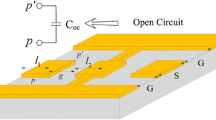Abstract
With the advancement of micro-electro-mechanical systems (MEMS) technologies, it is compulsory to have the sources which power the micro devices at micron scale. Due to the miniaturization, compactness, inexpensive and ease of integration with the standard process compatibility, CMOS-MEMS capacitor is characterized. There are two major parts of characterization; static mode and dynamic mode. The moveable shuttle remains in static mode until the input voltage reaches to 50 V. In static mode, due to constant capacitance among stator and shuttle fingers, charge accumulates up to 1.17 pC and level of energy stored does not go so high. The shuttle fingers initially overlap with the stator fingers by 30 μm but in dynamic mode when the voltage raises above 50 V, moveable shuttle starts moving and fingers overlapping distance reaches to 50 μm with the increase in voltage of approximately 307 V. In dynamic mode, stored energy level increases from 30 to 1800 pJ. The stored energy increases exponentially in dynamic mode due to the increased overlapping of the fingers and against elastic forces of beams (1, 2, 3 and 4).










Similar content being viewed by others
References
Dennis JO et al (2016) Post micromachining of MPW based CMOS–MEMS comb resonator and its mechanical and thermal characterization. Microsyst Technol 22(12):2909–2919
Diab Y (2009) Etude et modélisation des super condensateurs: applications aux systèmes de puissance. Diss. Lyon 1
Fang DM et al (2008) Fabrication and dynamic analysis of the electrostatically actuated MEMS variable capacitor. Microsyst Technol 14(3):397–402
Guenoukpati A et al (2017) Computational method for the charging time of supercapacitors. 2017 IEEE PES Power Africa
Hah D (2018) Analytical design of linear variable capacitors with shaped-finger comb-drive actuators. 2018 Symposium on Design, Test, Integration & Packaging of MEMS and MOEMS (DTIP). IEEE
Miao P et al (2003) Micro-machined variable capacitors for power generation
Nathan M (2010) Micro-battery technologies for miniaturized implantable medical devices. Curr Pharm Biotechnol 11(4):404–410
Shavezipur M et al (2012) Linearization and tunability improvement of MEMS capacitors using flexible electrodes and nonlinear structural stiffness. J Micromech Microeng 22(2):025022
Shen C et al (2017) A review of on-chip micro supercapacitors for integrated self-powering systems. J Microelectromech Syst 26(5):949–965
Hah D. Analytical design of MEMS variable capacitors based on shaped-finger comb-drives. Microsyst Technol 1–12
Yan J et al (2018) MEMS-based thermoelectric–photoelectric integrated power generator. J Microelectromech Syst 28(1):1–3
Author information
Authors and Affiliations
Corresponding author
Additional information
Publisher's Note
Springer Nature remains neutral with regard to jurisdictional claims in published maps and institutional affiliations.
Rights and permissions
About this article
Cite this article
Ahmad, F., Baig, A., Dennis, J.O. et al. Characterization of MEMS comb capacitor. Microsyst Technol 26, 1387–1392 (2020). https://doi.org/10.1007/s00542-019-04671-1
Received:
Accepted:
Published:
Issue Date:
DOI: https://doi.org/10.1007/s00542-019-04671-1




